The nice mail lady handed me a book-sized box while commenting about its weight; “heavy!” Indeed it was. Opening the box, a rugged but well-built piece of body armor appeared. Infidel Combat Systems contoured plate is rated to resist most rifle impacts, per the claim on their website. We see if that claim is accurate with an AR550 body armor test.
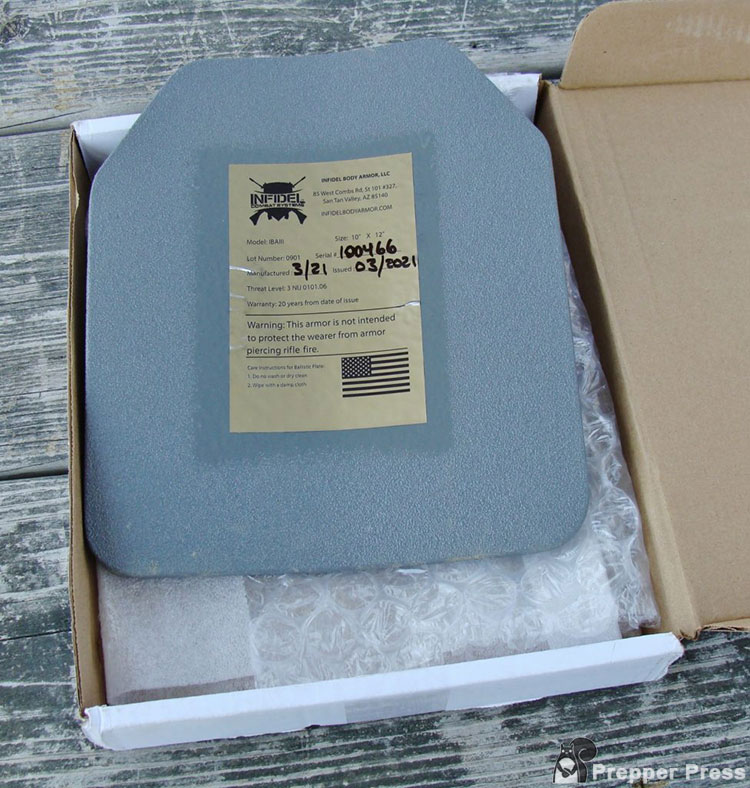
Their exact claim:
AR550 is 10% stronger/harder than AR500 Steel, based on the Brinell Hardness ratings. All of our armor is tested to stop the threats listed above. NIJ Rating of level III is only rated to stop a .308; however, our armor will stop additional threats like the green-tipped AR15 rounds.
Infidel Body Armor
Let’s start with the basics…
What is AR550 Steel?
AR550 is hardened steel that has a higher carbon content and is constructed through a hardening and tempering process to avoid becoming brittle. The “AR” stands for abrasion resistant. It is treated through quench tempering, which strengthens the steel through heating the material while simultaneously cooling it in water, nitrogen, or some other cooling medium. The “550” is its rating of Brinnell Hardness.
What is AR550 Rated For?
Infidel says this plate is made from the 1/4″ abrasion-resistant Brinell Hardness 550 steel (AR550) designed to armor military vehicles. A 1/4″ polymer coating surrounds the metal to capture bullet fragments. The claim is that AR550 will stop “5.56, .223, 7.62, 30-06, .357 mag, .45, 9mm, 12 Gauge Shotgun slugs, and more.”
Is AR550 Stronger than AR500 Steel?
Yes. Both are designed to withstand bullets, however AR550 has a longer-term durability, designed to withstand repeated shots. This is why many steel plate targets use AR550 steel, not AR500. That said, AR500 steel has been used as body armor by the U.S. military, security contractors, etc. However, AR550 is known to be stronger, better able to withstand rifle rounds.
What is Level III+ Body Armor?
Body armor is tested and rated based on standards from the National Institute of Justice (NIJ). They are the entity that publishes the Ballistic Resistance of Body Armor NIJ Standard-0101.06 (download the standards). Type III hard body armor plates, as we used here, are tested with 7.62mm FMJ, steel jacketed bullets (M80) with a specified mass of 147gr and a velocity of 2780 ft/s.
Level III+ body armor meets and exceeds Type III body armor standards set by the NIJ, but falls short of Type IV armor. Type IV body armor standards must stop .30 caliber armor piercing bullets with a specified mass of 166gr and a velocity of 2880 ft/s.
What Will AR550 Stop?
Again, the claim is that AR550 will stop “5.56, .223, 7.62, 30-06, .357 mag, .45, 9mm, 12 Gauge Shotgun slugs, and more.” My mission in this test was to see how AR550 body armor would fare with some of these calibers, as well as a few others.
Based on our test, we found that AR550 armor will stop all of the following:
- 9mm Speer 124gr Gold Dot JHP
- .357 Magnum 158gr Super-X JHP
- .44 Magnum Speer 200gr JHP
- .223 Hornady 62gr Barrier Penetrator TAP
- .308 Hornady 168gr A-MAX TAP
- .300 Short-Action Ultra-Mag Barnes 150gr TSX Handload
- .350 Remington Magnum, Hornady 200gr SP Interlock Handload
The plate is sized 10 x 12-inches to fit most body armor carriers. Weight is listed as 9 pounds; “a bit more than “ceramic or SAPI plates, but MUCH more durable.”
Let’s look at the details of this test, but first…
Background to the Test
My experience with various forms of projectile-resistant materials goes back to Vietnam era flak jackets. Made from thick yet soft materials, they were designed to stop shrapnel (though mine also saw regular use as a pillow).
Those of us that strapped noisy flying machines to our butts upgraded to hardened “chicken plates” made from the ceramic laminations (actually, we used two of these systems, sitting on the second with our “sidearms” relocated to protect the family jewels). The plates were rated to “stop a .30-caliber bullet at 100 meters.”
The exact type was never mentioned but experience proved they did work against a number of energetic projectiles such as the 7.62×54 Russian. Their downside was weight, which eventually led to today’s products made from Kevlar fibers (with smaller metal trauma-plate inserts).
Later, during my tenure with a government firearms training unit, we sometimes tested vests, as well as other bullet-resistant items like ballistic glazing. I’ll skip their various rating aspects in favor of some observations that influenced the final Infidel test-load choices.
Glazing (for Context)
Some impact resistant “glass” panels we tested over the years were actually thick laminations of plexiglass. Those rated for up to .44 Magnum would work as advertised. They also illustrated the relationship of a projectiles frontal area (and velocity) to penetration. Forty-grain .22 LR bullets typically imbedded in the surface, but 230-grain .45 ACP “ball” could literally bounce off after leaving a shallow crater – while ricocheting dangerously. Various other handgun calibers up to .44 Magnums were captured within the plexiglass. However, a 55-grain .223 FMJ bullet would drill clean though as if it was made from butter!
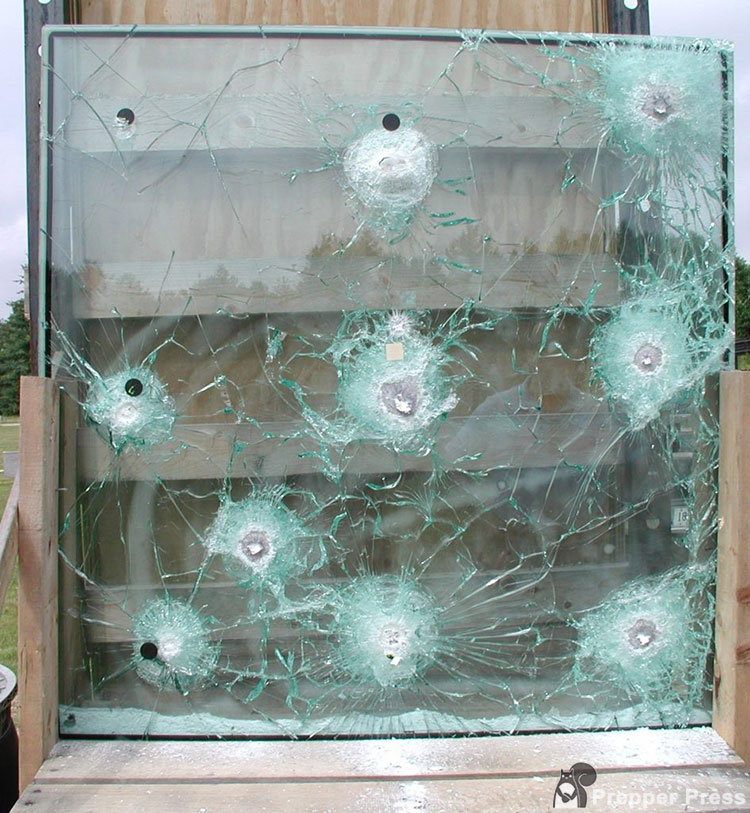
Testing of rifle-rated glazing was also interesting. Over the years we shot a number of panels made from similar plexiglass laminations. However, the “attack side” was faced with additional laminations of safety glass, attached by a silicone border.
In-between was an air space. The hard glass deformed the bullet’s tip to limit its penetration in the dense plexi medium. It worked so well that some .223 rounds were totally destroyed by the glass. Other heavy-hitters, including .338 Win. Magnums, were captured within the plexiglass, producing a large bulge at the rear. As impressive as this is, a WW II-era .30/06 armor piercing round would drill clean through. Why? No tip deformation.
Body Armor
We’ve seen similar effects with numerous samples. During one more recent session, soft armor effectively stopped every handgun round thrown at it – including .500 S&W bullets which were turned into thick flat wafers (supposedly, a challenge for earlier designs was 9mm FMJ due to its pointier profile).
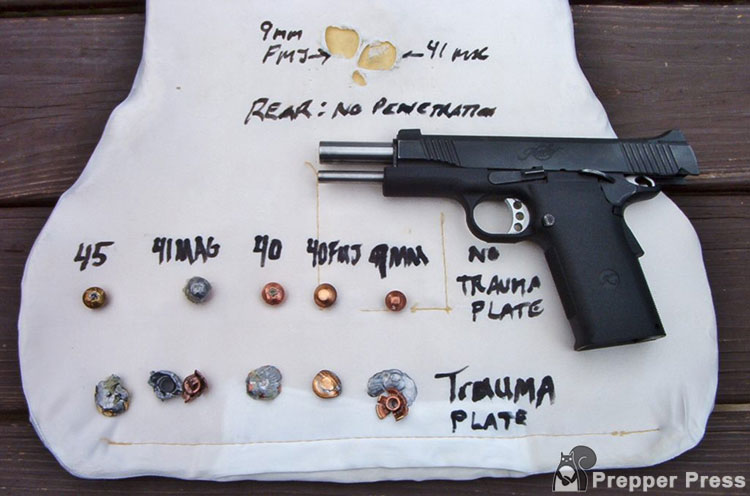
After shelving the big S&W, we broke out a plain-Jane AR-15 carbine. A basic 5.56 FMJ round punched clean through as if it was Swiss cheese. Not much mass – especially compared to the hefty .500s, but lots of velocity focused on the tiny tip.
Infidel AR550 Body Armor Test
I was given a single plate of AR550 to test. Wearers would, of course, need two of these and a plate carrier to wear them. They’re heavy, so it’s certainly not armor you’re going to run around in – unless you’re very fit or training to become a Navy SEAL.
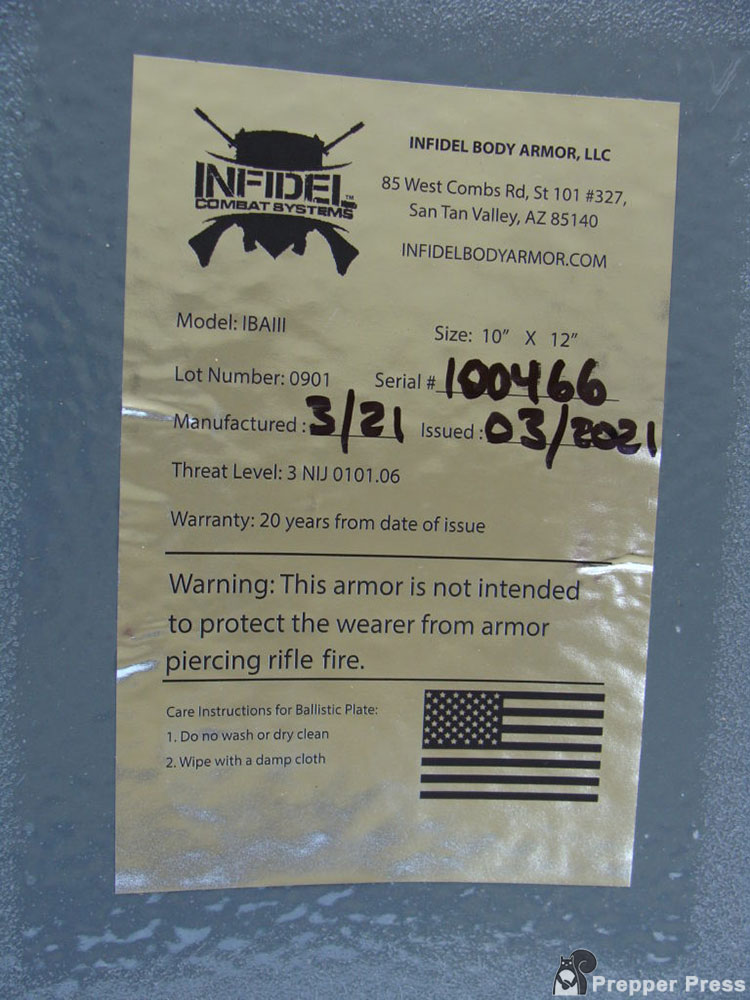
Based on the prior body armor tests mentioned above (which included some thrilling ricochets), I ran two different test phases. The coating of the Infidel’s plate was reassuring, but I still shot the handgun phase with a bit of distance, from 15 yards. The rifle phase was fired from 25 yards.
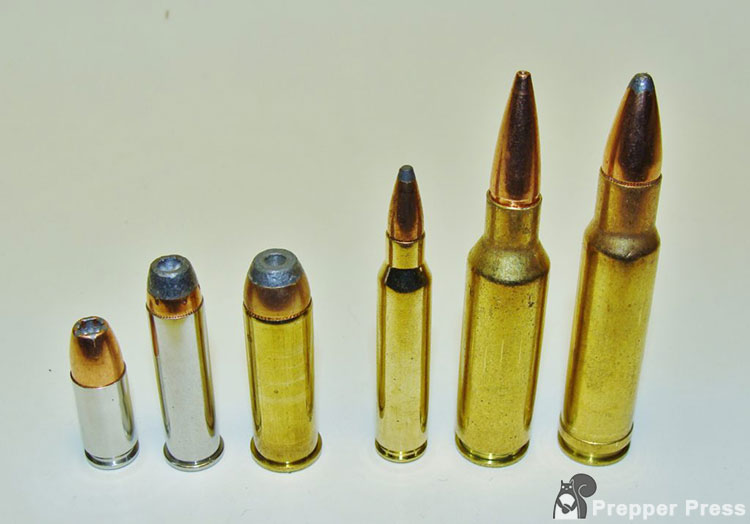
Rather than just blast away, per our previous protocols, I laid out a grid of black circles to help isolate each impact for more meaningful examinations. A cardboard IPSC target was also positioned at a 90-degree angle to record any spalling (pieces of bullet material). Shots were fired off a bench.
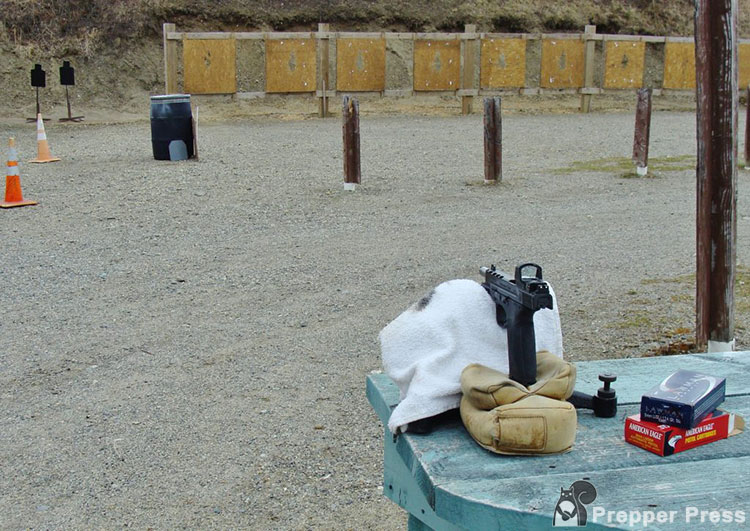
Test 1: Handguns vs AR550 at 15 Yards
The first AR550 body armor test was to be performed with a few handgun choices. Experience indicated .22 rimfires and smaller-caliber centerfire cartridges would probably just squander plate space. Same concerning .45 ACP. I did leave enough room in the grid to revisit different calibers in the event of a failure but, truthfully, none were expected.
The plate was propped securely against a plastic 55-gallon drum (at 15 yards) with the cardboard IPSC target positioned to its left side.
9mm Speer 124 Grain Gold Dot JHP / S&W M&P Pro, 5”
No penetration. There was some outward bulging of the polymer coating surrounding the impact point – along with a tipped-over plate.
.357 Magnum Winchester 158 Grain Super-X JHP / S&W Model 686, 6”
No penetration. Turned out the dot-sight’s battery was nearly dead, rendering the dot invisible. I overcame this problem by moving into our range building. Once inside, I fired the shot offhand through the doorway (the plate was relocated and braced against a telephone pole). Noisy, and not as close to the little circle.
.44 Magnum Speer 200 Grain JHP Handload / S&W Model 629 PC 7”
No penetration. I’ve used this warm load for years. Other than a more energetic reaction from the plate, results were the same. Good enough!
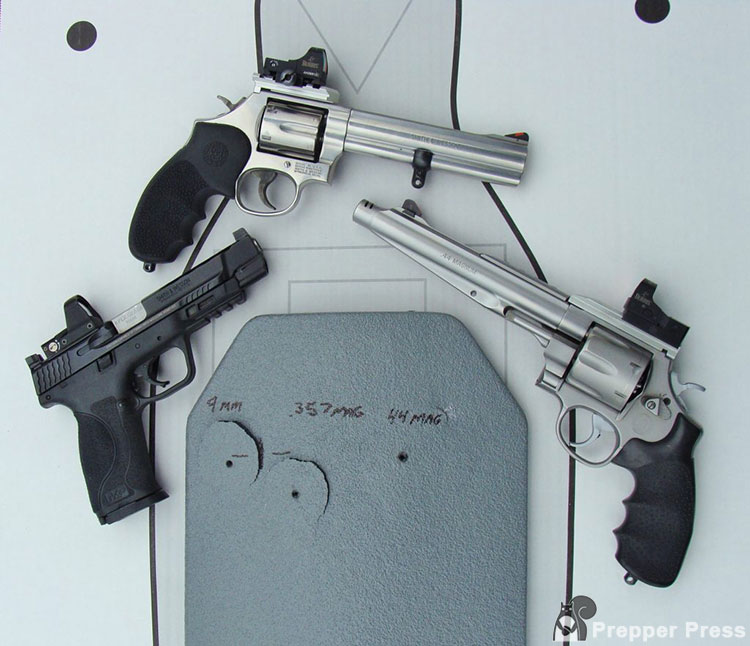
Comments. I saved a spot for a .300 Blackout round, topped by a Barnes 110 TAC-TX solid-copper bullet. My intent was to fire it from a 10 ½” AR pistol at 2200 fps. Instead, I decided to amp up this shot through a switch to a feistier rifle. As for spalling, absolutely none was recorded on the right-angle cardboard IPSC target, and no fragments were detected. Time to move on…
Test 2: Rifles vs AR550 at 25 Yards
The second AR550 body armor test included a few different rifles. The .223 and .308 choices were obligatory based on the ratings of the plate. I searched high and low for an errant 5.56 green-tip round, but wound up using Hornady’s 62-grain Barrier Penetrator load. Rewinding to .357 Magnums, the above WW Super-X gains lots of steam when fired through a rifle.
I considered its inclusion here but then opted to go all-in through a super-sized .357 version. The plate was braced for impact against a solidly planted 6×6 support pole on our target line. A cardboard IPSC target was stapled 90 degrees to the plate’s right side.
.223 Hornady 62 Grain Barrier Penetrator TAP / Remington Model 700 Compact Tactical, 20”
No penetration. This load was developed for nuclear security purposes. It uses a tough dual-purpose bullet designed to penetrate steel fire doors, with expansion capabilities to boot. Surprisingly, less plate damage was evident than any of the handgun shots. Its rear surface was flawless. So was the cardboard target.
.308 Hornady 168 Grain A-MAX TAP (2625 fps*) / Remington Model 700 HB, 20”
No penetration, slight bulging. The A-MAX caused some bulging of the polymer coating (similar to the handgun impacts), but none was evident on the rear face. Obviously, the design was sound!
.300 Short-Action Ultra-Mag, Barnes 150 Grain TSX Handload (3100 fps*) / Remington Model Seven, 22”
No penetration, some bulging. The .300 SAUM is similar to Winchester’s .300 Short-Mag. Performance of both is near .300 Winchester Magnum. The solid-copper Barnes is an especially tough bullet. It’ll penetrate deer lengthwise, and I’ve fired several through formalized gel tests where it’s always been the penetration champ.
This shot caused some bulging around the polymer impact point, accompanied by some tiny protruding copper fragments. There was a noticeable but minor bulge in the rear surface of the plate. Impressive results! I saw no reason to revisit the .300 BLK load.
.350 Remington Magnum, Hornady 200 Grain SP Interlock Handload (2670 fps*) / Remington Model Seven Custom Kevlar, 20”
No penetration. Wow, serious break-dancing from the plate (this combination will move a shooter, too)! Same diameter bullet as a .357 Magnum; the reason I upgraded to this entre. The polymer coating displayed radial splits and some minor separation was evident along the bottom edge of the plate. This impact was centered, so it coincided with the rear label, which had split from an obvious bulge. BUT, there was no penetration!
*Actual chronographed muzzle velocities.
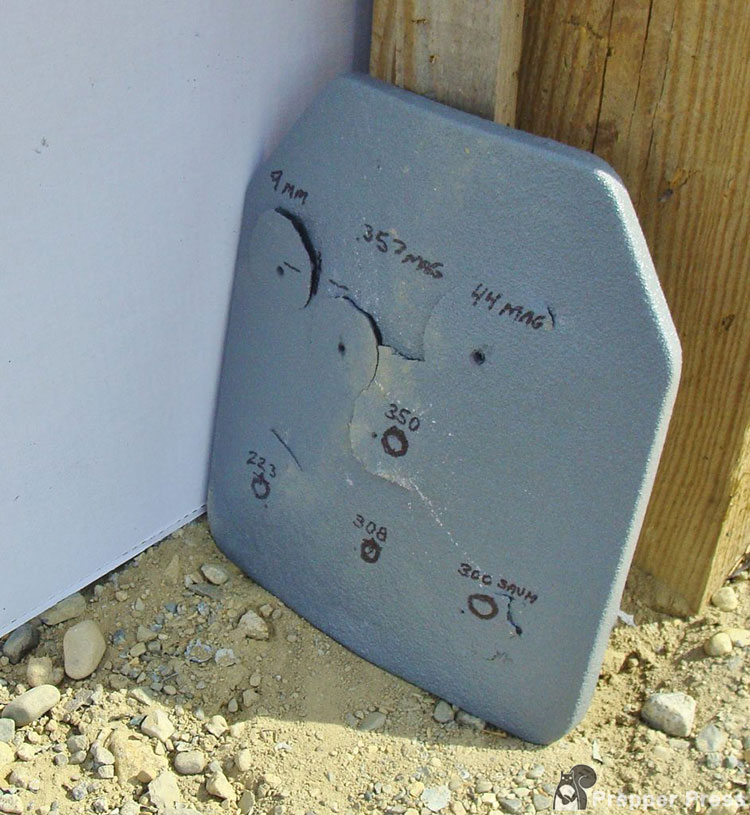
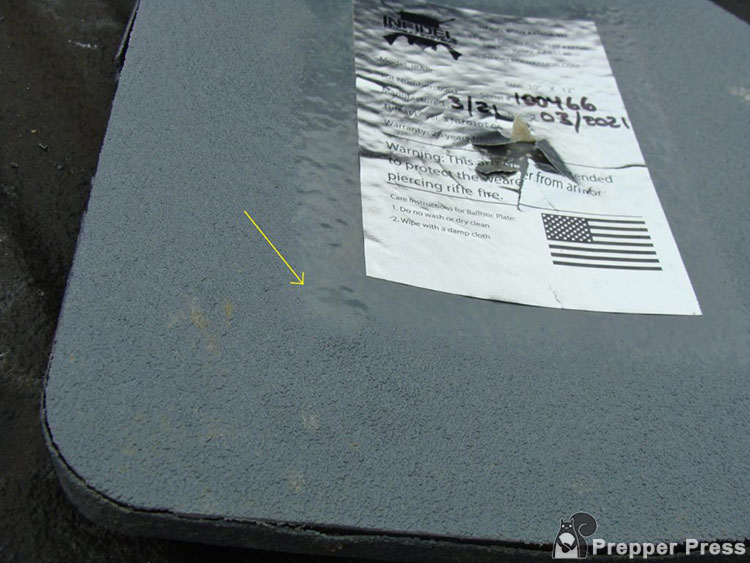
Comments. The need for further test-shots seemed moot, save the one below. Funny thing about the rifle entrance holes – they were really tiny. We’ve seen this often when sniping golf balls with .223 and .308 rifles at 100 yards.
The entrance is the size of a lead pencil tip, making it hard to find (although exits are unmistakable). That’s a good thing in light of spalling hazards, and so far I’d found none beyond a couple miniscule holes.
Deflection Shot
You can’t conduct an AR550 body armor test without a few deflection shots. Up to this point, the test shots had been pretty much straight-on, but real-world events are seldom static, so I repositioned the plate for a quartering impact. The shot was another .308 Hornady 168 A-Max, fired per the photo, near the plate’s outer edge.
The results were expectedly nasty. Physics being what they are, bullet fragments were driven under the polymer, which suffered lots of edge separation. The adjacent IPSC target shows what happened from there. FYI, this why we train shooters not to crowd cover.
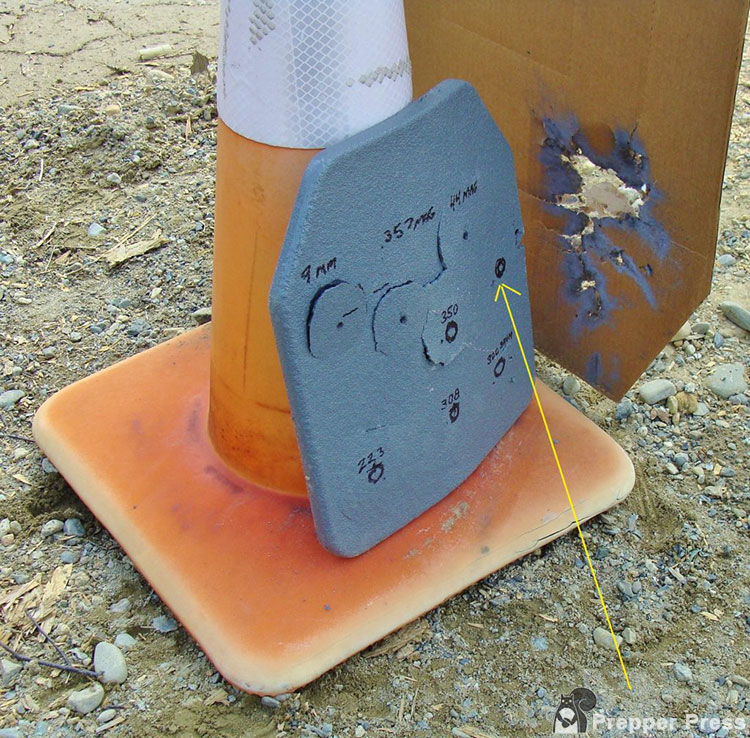
Note the huge amount of lead splatter!
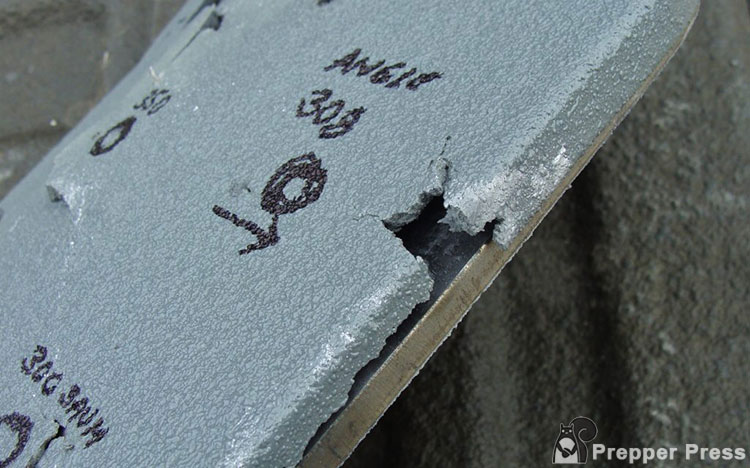
Other Calibers – Or Gauges?
The Infidel AR550 body armor test included a fairly broad representation of metallic cartridges. Thus, I saw little reason to continue and muddy the results. As for shotgun slugs, once in a while, exciting things can happen when big .73-caliber ‘bullets” collide with hard surfaces.
Also, there are now several different slug iterations, including sabot-types with projectiles of various diameters and alloys. For the record, we have a huge amount of rifled-slug experience due to decades of shotgun training. Given their large frontal areas, soft composition, and closer-to-handgun velocity, the main damage I’d expect would be delamination of the plate’s coating.
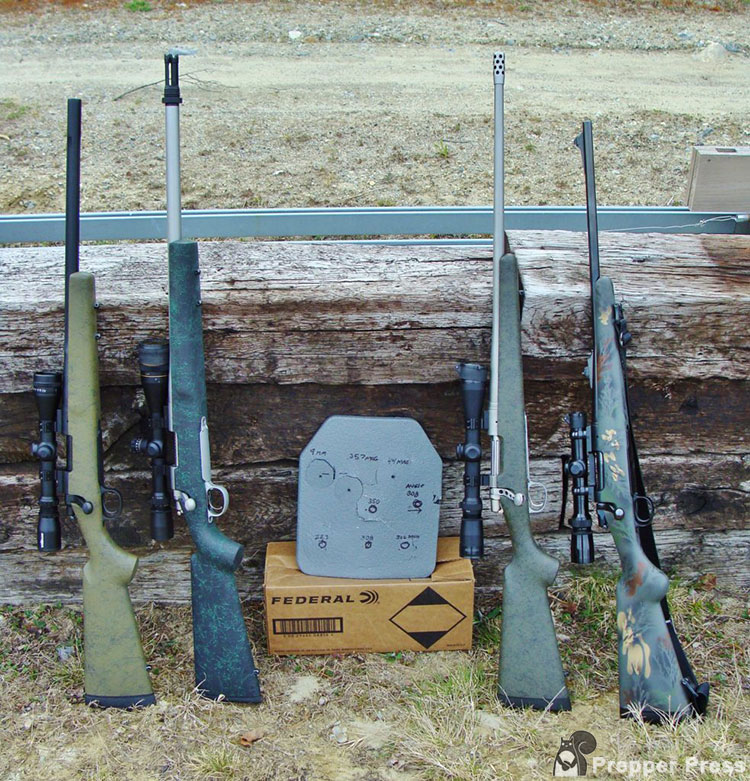
The Infidel is modeling the abuse while clinging to a moving-target system.
Conclusion
Few technologies are perfect, even without any cost limitations. Considering its reasonable price, the AR550 body armor test showed surprisingly good results. Yes, it could be bigger, but the dimensions are sized to fit carriers. Also, each extra square inch translates to more weight. Nine pounds might not seem like much but that will double with a rearward addition.
As of this writing, an individual plate is listed at $164.99. A pair costs $299.99.
One thing that caught my attention when I opened the box was the obvious attention to details. True, it’s really “just a plate,” but manufacturing appeared to be flawless, and that’s reassuring considering its intended purpose.
